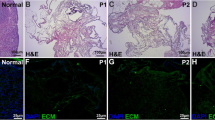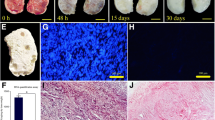Abstract
The present study assessed the supportive roles of the decellularized human ovarian tissue in homing of mouse fetal ovarian cells into the scaffold as well as the formation of the follicular-like structure. The human ovarian cortical tissues were decellularized by three freeze-thaw cycles and then, treated with Triton X-100 for 15 h and 0.5% sodium dodecyl sulfate for 72 h. After isolation and preparation of mouse fetal ovarian cells (19 dpc) they were seeded into the decellularized scaffolds and cultured for 7 days, then using a light microscope, laser confocal scanning microscope, and scanning electron microscope these scaffolds were studied. Analysis of gene expression related to oocyte and follicular cells such as Ddx4, Nobox, Gdf9, and Connexin37 was assessed by real-time RT-PCR and the DDX4 and GDF9 proteins were detected by immunohistochemistry. The result showed that the human ovarian tissue was decellularized properly and the tissue elements and integrity were well preserved. After 7 days of in vitro culture, the fetal ovarian cells attached and penetrated into different sites and depths of the scaffold. The formed organoid within the scaffold showed large round, small polyhedral, and elongated spindle cells similar to the follicle structure. The molecular analysis and immunohistochemistry were confirmed an increase in the expression of genes and proteins related to oocyte and follicular cells in these reconstructed structures. In conclusion, the recellularization of human ovarian scaffolds by mouse fetal ovarian cells could support the follicular-like structure formation and it provides an in vitro model for follicle reconstitution and offers an alternative approach for clinical usage.






Similar content being viewed by others
References
Alaee S, Asadollahpour R, Hosseinzadeh Colagar A, Talaei-Khozani T (2021) The decellularized ovary as a potential scaffold for maturation of preantral ovarian follicles of prepubertal mice. Syst Biol Reprod Med 67:413–427. https://doi.org/10.1080/19396368.2021.1968542
Alshaikh AB, Padma AM, Dehlin M, Akouri R, Song MJ, Brännström M, Hellström M (2019) Decellularization of the mouse ovary: comparison of different scaffold generation protocols for future ovarian bioengineering. J Ovarian Res 12:58. https://doi.org/10.1186/s13048-019-0531-3
Arapaki A, Christopoulos P, Kalampokas E, Triantafyllidou O, Matsas A, Vlahos NF (2022) Ovarian tissue cryopreservation in children and adolescents. Child (Basel) 9:1256. https://doi.org/10.3390/children9081256
Buckenmeyer MJ, Sukhwani M, Iftikhar A, Nolfi AL, Xian Z, Dadi S, Case ZW, Steimer SR, D’Amore A, Orwig KE, Brown BN (2020) Bioengineering an in situ ovary (ISO) for fertility preservation. bioRxiv. https://doi.org/10.1101/2020.01.03.893941
Canovas S, Campos R, Aguilar E, Cibelli JB (2017) Progress towards human primordial germ cell specification in vitro. Mol Hum Reprod 23:4–15. https://doi.org/10.1093/molehr/gaw069
Chen J, Torres-de la Roche LA, Kahlert UD, Isachenko V, Huang H, Hennefründ J, Yan X, Chen Q, Shi W, Li Y (2022) Artificial ovary for young female breast cancer patients. Front Med (Lausanne) 9:837022. https://doi.org/10.3389/fmed.2022.837022
Chiti MC, Vanacker J, Ouni E, Tatic N, Viswanath A, Des Rieux A, Dolmans MM, White LJ, Amorim CA (2022) Ovarian extracellular matrix-based hydrogel for human ovarian follicle survival in vivo: a pilot work. J Biomed Mater Res B Appl Biomater 110:1012–1022. https://doi.org/10.1002/jbm.b.34974
Cho E, Kim YY, Noh K, Ku SY (2019) A new possibility in fertility preservation: the artificial ovary. J Tissue Eng Regen Med 13:1294–1315. https://doi.org/10.1002/term.2870
Clarkson YL, McLaughlin M, Waterfall M, Dunlop CE, Skehel PA, Anderson RA, Telfer EE (2018) Initial characterisation of adult human ovarian cell populations isolated by DDX4 expression and aldehyde dehydrogenase activity. Sci Rep 8:6953. https://doi.org/10.1038/s41598-018-25116-1
De Castro FC, Cruz MHC, Leal CLV (2016) Role of growth differentiation factor 9 and bone morphogenetic protein 15 in ovarian function and their importance in mammalian female fertility-A review. Asian-Australas J Anim Sci 29:1065–1074. https://doi.org/10.5713/ajas.15.0797
Dolmans M-M, Luyckx V, Donnez J, Andersen CY, Greve T (2013) Risk of transferring malignant cells with transplanted frozen-thawed ovarian tissue. Fertil Steril 99:1514–1522. https://doi.org/10.1016/j.fertnstert.2013.03.027
Dong J, Albertini DF, Nishimori K, Kumar TR, Lu N, Matzuk MM (1996) Growth differentiation factor-9 is required during early ovarian folliculogenesis. Nature 383:531–535. https://doi.org/10.1038/383531a0
Eivazkhani F, Abtahi NS, Tavana S, Mirzaeian L, Abedi F, Ebrahimi B, Montazeri L, Valojerdi MR, Fathi R (2019) Evaluating two ovarian decellularization methods in three species. Mater Sci Eng C Mater Biol Appl 102:670–682. https://doi.org/10.1016/j.msec.2019.04.092
Elvin JA, Yan C, Wang P, Nishimori K, Matzuk MM (1999) Molecular characterization of the follicle defects in the growth differentiation factor 9-deficient ovary. Mol Endocrinol 13:1018–1034. https://doi.org/10.1210/mend.13.6.0309
Eppig JJ, Wigglesworth K (2000) Development of mouse and rat oocytes in chimeric reaggregated ovaries after interspecific exchange of somatic and germ cell components. Biol Reprod 63:1014–1023. https://doi.org/10.1095/biolreprod63.4.1014
Gittens JE, Barr KJ, Vanderhyden BC, Kidder GM (2005) Interplay between paracrine signaling and gap junctional communication in ovarian follicles. Cell Sci 118:113–122. https://doi.org/10.1242/jcs.01587
Hassanpour A, Talaei-Khozani T, Kargar-Abarghouei E, Razban V, Vojdani Z (2018) Decellularized human ovarian scaffold based on a sodium lauryl ester sulfate (SLES)-treated protocol, as a natural three-dimensional scaffold for construction of bioengineered ovaries. Stem Cell Res Ther 9:252. https://doi.org/10.1186/s13287-018-0971-5
Hoekman EJ, Louwe LA, Rooijers M, van der Westerlaken LAJ, Klijn NF, Pilgram GSK, de Kroon CD, Hilders CGJM (2020) Ovarian tissue cryopreservation: low usage rates and high live-birth rate after transplantation. Acta Obstet Gynecol Scand 99:213–221. https://doi.org/10.1111/aogs.13735
Huntriss J, Hinkins M, Picton HM (2006) cDNA cloning and expression of the human NOBOX gene in oocytes and ovarian follicles. Mol Hum Reprod 12:283–289. https://doi.org/10.1093/molehr/gal035
Jakus AE, Laronda MM, Rashedi AS, Robinson CM, Lee C, Jordan SW, Orwig KE, Woodruff TK, Shah RN (2017) Tissue Papers from organ-specific decellularized extracellular matrices. Adv Funct Mater 27:1700992. https://doi.org/10.1002/adfm.201700992
Kinnear HM, Tomaszewski CE, Chang FL, Moravek MB, Xu M, Padmanabhan V, Shikanov A (2020) The ovarian stroma as a new frontier. Reproduction 160:R25–R39. https://doi.org/10.1530/REP-19-0501
Laronda MM, Jakus AE, Whelan KA, Wertheim JA, Shah RN, Woodruff TK (2015) Initiation of puberty in mice following decellularized ovary transplant. Biomaterials 50:20–29. https://doi.org/10.1016/j.biomaterials.2015.01.051
Lei L, Zhang H, Jin S, Wang F, Fu M, Wang H, Xia G (2006) Stage-specific germ‐somatic cell interaction directs the primordial folliculogenesis in mouse fetal ovaries. J Cell Physiol 208:640–647. https://doi.org/10.1002/jcp.20702
Liu W-Y, Lin S-G, Zhuo R-Y, Xie Y-Y, Pan W, Lin X-F, Shen FX (2017) Xenogeneic decellularized scaffold: a novel platform for ovary regeneration. Tissue Eng Part C Methods 23:61–71. https://doi.org/10.1089/ten.TEC.2016.0410
Medrano JV, Ramathal C, Nguyen HN, Simon C, Reijo Pera RA (2012) Divergent RNA-binding proteins, DAZL and VASA, induce meiotic progression in human germ cells derived in vitro. Stem Cells 30:441–451. https://doi.org/10.1002/stem.1012
Monti M, Redi C (2009) Oogenesis specific genes (Nobox, Oct4, Bmp15, Gdf9, Oogenesin1 and Oogenesin2) are differentially expressed during natural and gonadotropin-induced mouse follicular development. Mol Reprod Dev 76:994–1003. https://doi.org/10.1002/mrd.21059
Nagyová E, Němcová L, Camaioni A (2021) Cumulus extracellular matrix is an important part of oocyte microenvironment in ovarian follicles: its remodeling and proteolytic degradation. Int J Mol Sci 23:54. https://doi.org/10.3390/ijms23010054
Nikniaz H, Zandieh Z, Nouri M, Daei-Farshbaf N, Aflatoonian R, Gholipourmalekabadi M, Jameie SB (2021) Comparing various protocols of human and bovine ovarian tissue decellularization to prepare extracellular matrix-alginate scaffold for better follicle development in vitro. BMC Biotechnol 21:1–8. https://doi.org/10.1186/s12896-020-00658-3
Park E-S, Tilly JL (2015) Use of DEAD-box polypeptide-4 (Ddx4) gene promoter-driven fluorescent reporter mice to identify mitotically active germ cells in post-natal mouse ovaries. Mol Hum Reprod 21:58–65. https://doi.org/10.1093/molehr/gau071
Rodrigues P, Limback D, McGinnis L, Marques M, Aibar J, Plancha CE (2021) Germ–somatic cell interactions are involved in establishing the follicle reserve in mammals. Front Cell Dev Biol 9:674137. https://doi.org/10.3389/fcell.2021.674137
Pors S, Ramløse M, Nikiforov D, Lundsgaard K, Cheng J, Andersen CY, Kristensen SG (2019) Initial steps in reconstruction of the human ovary: survival of pre-antral stage follicles in a decellularized human ovarian scaffold. Hum Reprod 34:1523–1535. https://doi.org/10.1093/humrep/dez077
Rajkovic A, Pangas SA, Ballow D, Suzumori N, Matzuk MM (2004) NOBOX deficiency disrupts early folliculogenesis and oocyte-specific gene expression. Science 305:1157–1159. https://doi.org/10.1126/science.1099755
Simon AM, Goodenough DA, Li E, Paul DL (1997) Female infertility in mice lacking connexin 37. Nature 385:525–529. https://doi.org/10.1038/385525a0
Sistani MN, Zavareh S, Valujerdi MR, Salehnia M (2021) Characteristics of a decellularized human ovarian tissue created by combined protocols and its interaction with human endometrial mesenchymal cells. Prog Biomater 10:195–206. https://doi.org/10.1007/s40204-021-00163-6
Stocker WA, Walton KL, Richani D, Chan KL, Beilby KH, Finger BJ, Green MP, Gilchrist RB, Harrison CA (2020) A variant of human growth differentiation factor-9 that improves oocyte developmental competence. J Biol Chem 295:7981–7991. https://doi.org/10.1074/jbc.RA120.013050
Suzumori N, Yan C, Matzuk MM, Rajkovic A (2002) Nobox is a homeobox-encoding gene preferentially expressed in primordial and growing oocytes. Mech Dev 111:137–141. https://doi.org/10.1016/s0925-4773(01)00620-7
Teng Z, Wang C, Wang Y, Huang K, XiangX, Niu W, Feng L, Zhao L, Yan H, Zhang H (2016) Gap junctions are essential for murine primordial follicle assembly immediately before birth. Reproduction 152:105–115. https://doi.org/10.1530/REP-15-0282
Wang H, Xia G, Wang Q, Li M, Lu Z (2001) Follicles were reconstituted from dissociated mouse fetal ovarian cells in vitro. Chin Sci Bull 46:672–674. https://doi.org/10.1007/BF03182833
Wang Z, Liu C-Y, Zhao Y, Dean J (2020) FIGLA, LHX8 and SOHLH1 transcription factor networks regulate mouse oocyte growth and differentiation. Nucleic Acids Res 48:3525–3541. https://doi.org/10.1093/nar/gkaa101
Woodruff TK, Shea LD (2007) The role of the extracellular matrix in ovarian follicle development. Reprod Sci 14:6–10. https://doi.org/10.1177/1933719107309818
Acknowledgements
This work was supported by Tarbiat Modares University of Medical Sciences. Special thanks to Mr. Pour Beyranvand for her technical assistance.
Author information
Authors and Affiliations
Contributions
MNS: Performed the experiments, analyzed the data and contributed to writing the manuscript. MRV: involved in protocol development; MS and SZ: supervised the study and contributed to writing the manuscript. All authors reviewed and edited the manuscript and approved the final version of the manuscript.
Corresponding author
Ethics declarations
Competing interests
The authors declare no competing interests.
Ethical approval
This experimental study was endorsed by the Ethics Committee of Faculty of Medical Sciences of Tarbiat Modares University Tehran, Iran (IR.MODARES.REC.1398.006).
Informed consent
The preparation of human and mouse samples was according to the guidelines of the Ethics Committee of Faculty of Medical Sciences of Tarbiat Modares University and informed consents were obtained for usage of human tissues (No. 1398.006).
Additional information
Publisher’s Note
Springer Nature remains neutral with regard to jurisdictional claims in published maps and institutional affiliations.
Rights and permissions
Springer Nature or its licensor (e.g. a society or other partner) holds exclusive rights to this article under a publishing agreement with the author(s) or other rightsholder(s); author self-archiving of the accepted manuscript version of this article is solely governed by the terms of such publishing agreement and applicable law.
About this article
Cite this article
Sistani, M.N., Zavareh, S., Valojerdi, M.R. et al. Reconstruction of ovarian follicular-like structure by recellularization of a cell-free human ovarian scaffold with mouse fetal ovarian cells. Cytotechnology 76, 27–38 (2024). https://doi.org/10.1007/s10616-023-00595-x
Received:
Accepted:
Published:
Issue Date:
DOI: https://doi.org/10.1007/s10616-023-00595-x




